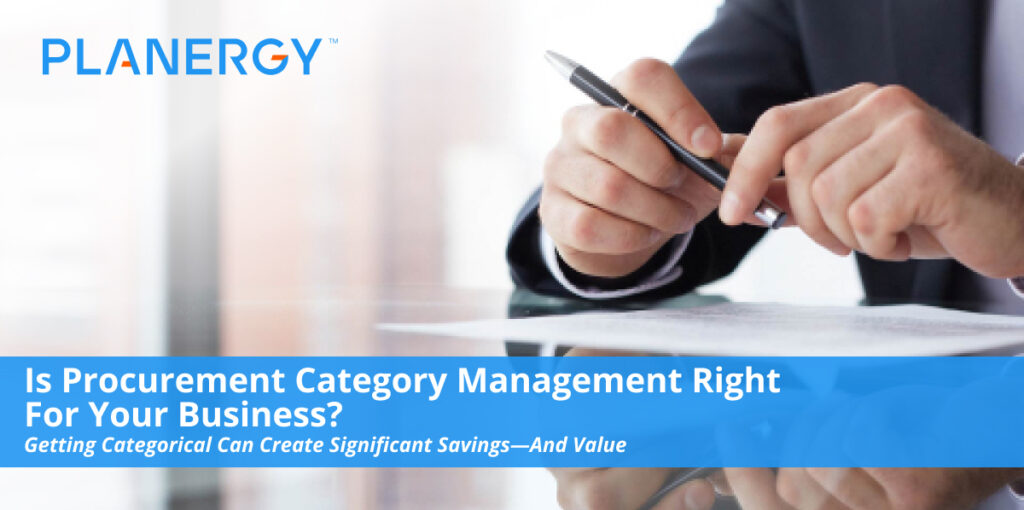Increasingly, companies of all sizes and industries seek to meet their needs through process optimization and strategic, organization-wide development of lasting overall value.
This shift in attitude has particular import for procurement organizations, which touch on every business unit and directly support both production and “the business of doing business.”
It’s unsurprising, then, that the days when procurement teams were perceived as a useful, if limited, source of cost savings rather than a potential wellspring of savings, profits, and value are rapidly fading into the past.
However, to reach its full potential as a value generator, the procurement process itself must be built on a procurement strategy that supports a company’s goals and meets its business needs.
Often, the first choice to be made when building a strategic approach to procurement is prioritizing either project procurement or procurement category management.
Both of these procurement strategies have their respective merits and limitations, but understanding the distinction between them is essential to effective procurement.
Project Procurement vs Procurement Category Management
The first step to strategic procurement is identifying the value-building goals that matter most to your company.
Do you prioritize long- or short-term procurement planning? Are versatility and agility more valuable than “big picture” strategies based on relationships and supply chain management?
Does lasting value come from cost savings, or increases driven by continuous improvement?
The answers to these questions can help you decide when considering which of these procurement strategies best meet the business needs of your internal customers.
Category management in purchasing is the process of defining areas of spend and effectively “roping off” goods, services, and the suppliers who provide them. By doing so, category managers can narrow their focus and conduct in-depth market analysis for decisions that generate long-term value through cost reductions and gains in productivity, competitive advantage, and internal controls.
Project Procurement
If you’re working within a relatively narrow scope and need to assemble a project-specific procurement team to meet project goals, project procurement is a smart choice.
This procurement strategy is most effective when you’re operating within specific, negotiated contractual guidelines.
Let’s say your construction firm is contracted to erect a new museum. At the macro level, the museum itself is simply a construction project, albeit one requiring an array of raw materials, finished goods, and professional services to complete.
The contract stipulates the timeframe and budget for the project, and the entire procurement process for the project will likely be managed by a team well-versed in project procurement.
The team will also most likely be led by a project manager who can collaborate to bring together the parties and materials necessary to complete the project as a whole while simultaneously managing the discrete sub-projects (each with subject matter experts and procurement professionals of its own) within it.
Because this method of procurement is, by its very nature, iterative rather than contiguous, the strategic priorities are focused on optimal contextual contract negotiation, rather than long-term supplier relationship management.
However, a savvy project procurement manager still understands the tactical and strategic import of cooperation between project-specific suppliers in completing the project on time and under budget.
Generally speaking, project procurement follows a set path, as dictated by the scope and budget of a project:
- Project management planning, including risk management, budgeting, development of documentation, scheduling, etc.
- Creation of a tendering process, e.g. Request for Proposal (RFP) or Request for Quote (RFQ), supported by Request for Information (RFI).
- Short-listing of potential vendors to establish a supply base.
- Negotiation and reward of contracts to selected supplier(s), with necessary additional guidance as required.
- Monitoring and adjustment of procurement activities based on supplier performance, including audits if necessary.
- Contract closings.
- Review of project-specific procurement activities, supplier performance, and analysis of collected data to drive future internal process improvements.
Iterative, flexible, and highly contextual, project-based procurement is a reactive strategy that can pay rich short-term dividends in the form of immediate profits for internal stakeholders or shareholders.
The ephemeral nature of each project is ideal for companies not based in manufacturing or retail, and whose procurement teams are highly skilled in extracting maximum value through negotiation and process efficiency, rather than advanced strategic supply chain management.
Procurement Category Management
If your company is built on a foundation of production or retail, it’s likely your procurement team faces constant expectations from internal customers to generate greater profitability and value through cost savings, process improvement, and strategic supplier relationships.
For companies like these, procurement category management allows sustained value creation through robust data management, economies of scale, and supplier relationship management focused on long-term shared prosperity, rather than one-off interactions.
Category management in purchasing is the process of defining areas of spend and effectively “roping off” goods, services, and the suppliers who provide them.
By doing so, category managers can narrow their focus and conduct in-depth market analysis for decisions that generate long-term value through cost reductions and gains in productivity, competitive advantage, and internal controls.
In procurement category management, the procurement team divides spend across specific and detailed categories of select goods and services.
Goods and services are segmented and arranged according to their function within the company.
These categories can include office information technology, management, human resources, professional services, medical, and industrial, among many more.
Category managers specialize in developing category plans within procurement.
They use spend and market analysis to parse each specific category for total spend, needs met and unmet, and potential areas of improvement.
In contrast to project procurement, a more strategic approach is applied in procurement category management, with much more weight given to long-term planning, market intelligence, spend analysis, and strategic sourcing.
For each category of spend, and the goods and services that support it, a category manager develops and implements a category strategy by:
- Identifying procurement opportunities through market analysis and analysis of internal transaction and performance data.
- Developing those procurement opportunities through refinement of new markets, product innovation, etc.
- Finalizing a procurement strategy for the category.
- Evaluating potential suppliers.
- Holding auctions and RFPs
- Negotiating for optimal terms, pricing, and service.
- Integrating winning vendors, monitoring supplier performance, and continuing to develop strategic relationships through supplier relationship management.
A category management approach simplifies demand, reduces costly redundancies, and enhances risk management through larger, long-term contracts, centralized purchasing management, and reduced chance of problems such as rogue spend, miscommunication, and compliance issues.
Economies of scale, properly leveraged in conjunction with strategic supplier relationship management, help ensure the lowest possible prices for the best quality goods.
Category management in procurement also helps foster deeper, more strategic partnerships with key vendors to build a significant source of long-term value and enhanced opportunities for growth and innovation.
It also gives companies a boost to competitive advantage through advanced data analytics and greater data transparency across the entire supply chain, as well as identification of optimal, value-focused suppliers for each category.
Choosing Between Procurement Category Management and Project Procurement
According to the Open Standards Benchmarking established by the American Productivity and Quality Center (APQC), companies with category management programs reap several benefits as compared to those without such programs.
The benefits of category management include:
- Improved purchase order (PO) processing times. Top performers using a category management approach averaged just 5 hours to place a purchase order, as compared to 44 hours for underperformers not using category management. Among bottom performers using category management, the average processing time was still just 12 hours, or nearly ¾ less than those without.
- Shorter supplier lead times. Top performers using category management had an average supplier lead time of 4 days. Bottom performers with category management waited more than twice as long on average (9 days), while bottom performers without category management averaged a month (30 days).
- Better data transparency. Consolidated and centralized spend data simplifies workflows much more readily than disjointed information collected from a dozen different projects using a handful of different evaluation criteria.
- Continuous Process Improvement. Replication of optimized processes means workflows, protocols, and processes that work for one vendor in a given category can be easily applied to others, whether it’s risk management, procure-to-pay (P2P), or data collection and analysis. This concept can be expanded to your entire procurement process through the use of a cloud-based, automation-driven procurement solution.
Naturally, these benefits will appeal immensely to companies based in manufacturing or retail, but they are certainly not exclusive to them.
Even companies who rely exclusively on project procurement can gain benefits from building a “meta” supply chain with category management to provide a supply base for current and future projects.
Doing so makes it easy to reap the benefits of spend data management and process improvements while preserving the ability to tweak project-specific procurement needs.
There’s room for both strategic and tactical procurement in the modern marketplace, particularly for companies looking to maximize their agility while building a strong and reliable supply chain.
Ultimately, what matters most is knowing your company’s long and short term business strategy, the needs that must be met to achieve organizational goals, and the priorities of internal customers, stakeholders, and shareholders.
How Will Your Procurement Team Build Value?
Don’t let sub-optimal procurement cost your company profits, efficiency, and value.
Whether you’re in it for the long haul or seeking a sprightly and agile approach, understanding how category management can build value for your business will help you create a profitable and productive procurement strategy.




